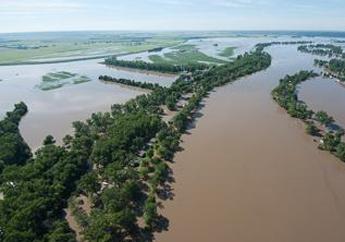
The amount of precipitation in a particular area varies from year to year, but over a period of years the average amount is fairly constant. A flood occurs when there is an overflowing of water onto land that is normally dry. Simply put, flooding occurs when the amount of water exceeds the ability of the ground to absorb it. Floods are the most common and widespread weather-related natural disaster.
A flood can occur within minutes or gradually over several days or weeks. A flood can last for several hours, days, weeks or even months. Heavy or excessive rainfall or snowmelt can cause water levels to rise over the tops of river and stream banks. Dam and flood-levee failures can send a sudden surge of water downstream, flooding areas near rivers. Paved roads, overwhelmed or plugged storm drains and limited green space reduces the amount of ground available to absorb water, which could cause flooding in towns and cities. Damaging flooding may occur with only a few inches of water to several feet.
Flash floods are the most dangerous kind of flood, combining the destructive power of a flood with incredible speed. During flash floods, water rises rapidly in a short amount of time, limiting the time available to warn and protect the public. If people are at their homes or businesses, the water may rise quickly and trap them. Flash floods have enough force to uproot trees, tear down buildings and bridges and cut out new water channels. It only takes six inches of fast-moving flood water to knock over an adult. It takes just 12 inches of rushing water to carry away most cars and just 2 feet of rushing water can carry away SUVs and trucks.
The following groups work on flooding issues:
*Individual river and stream reports provided below generally are available for one month.

